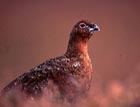Red Grouse 'At Risk of Extinction'
Parasitic disease is rife amongst red grouse due to warmer weather conditions as climate change continues to change almost every aspect of our natural environment.


The future of Britain's red grouse is in jeopardy following the death of vast quantities of birds from the disease strongylosis.
According to research undertaken by Game Conservancy Trust (GCT) scientists, climactic changes are at the root of the problem. Last year's warm wet autumn failed to kill off the parasitic larvae and by January there were signs of grouse dying of strongylosis, a disease caused by worms.
Morag Walker from the GCT told Countrylife.co.uk: 'The grouse are actually at risk of extinction if the situation continues'.
Grouse affected by the disease are usually seen from late February onwards, with the classic 'owl-like' flight from the red grouse the first indication of an outbreak.
When the ill birds are flushed they have a weak gliding flight usually in a downhill direction. Diseased grouse can also be found sitting in the heather, too weak to get up.
The parasites hatch in the birds' guts and burrow through their intestines, causing them to starve. The worms also make the birds give off a strong smell, which makes them more vulnerable to predators.
The GCT is working hard to find new ways of treating the disease. 'Grouse naturally eat grit in order to break down the heather they live off,' explains Walker, 'By medicating the grit the birds can be treated'.
Exquisite houses, the beauty of Nature, and how to get the most from your life, straight to your inbox.
Game birds, particularly those in Scotland, are also under threat from ticks, which are hatching earlier in warmer temperatures and infesting swathes of grouse moor. The blood-sucking parasites can kill up to 80% of bird populations by infecting them with a virus.
'Game keepers rely on sheep dipping to kill off ticks but with less sheep on the hill due to the cattle reform ticks have been able to breed' says Alex Hogg, Chairman of the Scottis Game Keeper's Association. Hogg also blames the rise in parasites on milder winters and gamekeepers being unable to scorch the heather.
The news comes weeks after a report called 'Nature's Gain' identified that England's 4,428 km of managed grouse moors are a huge benefit to Britain's wildlife population.
Dr Stephen Tapper, Director of Policy and Public Affairs at the GCT, who wrote the report claims: 'To a large extent the wildlife crown jewels we have today, the Sites of Special Scientific Interest and Special Protection Areas, we have inherited from the sporting interests of the 19th and 20th centuries.' Impressive numbers of curlews, plovers and golden plovers are found on Britain's grouse moors and are thankfully unaffected by the virus.
Moorland owners are well used to highs and lows in grouse shooting, but the fact that the grouse population was already down due to high winds during last year's breeding season has meant that the grouse numbers are far lower than usual. 'The population has been knocked back hugely,' says Walker.
Intensive treatment coupled with this season's dry weather, which has destroyed the virus, will hopefully give the grouse population a chance to recover, but many who look after these environments are hoping this is not just a sign of things to come.
Do you have any news stories forCountrylife.co.uk? Email theNews DeskTo top> >
Country Life is unlike any other magazine: the only glossy weekly on the newsstand and the only magazine that has been guest-edited by His Majesty The King not once, but twice. It is a celebration of modern rural life and all its diverse joys and pleasures — that was first published in Queen Victoria's Diamond Jubilee year. Our eclectic mixture of witty and informative content — from the most up-to-date property news and commentary and a coveted glimpse inside some of the UK's best houses and gardens, to gardening, the arts and interior design, written by experts in their field — still cannot be found in print or online, anywhere else.
